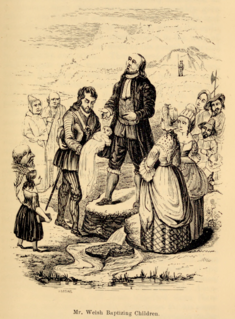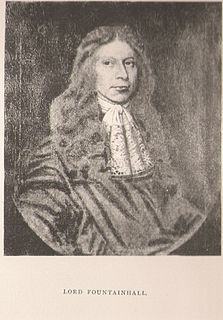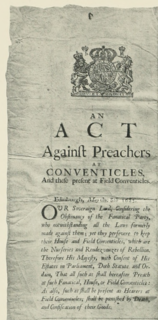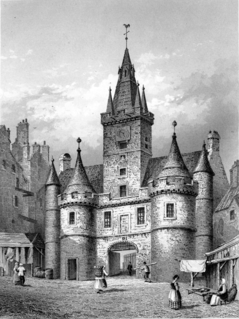
John Michael Welsh of Irongray was a leader of the Scottish Covenanter movement. Dunlop an early 20th century writer says: "It is a noteworthy fact that there exists no memoir of John Welsh of Irongray, though from the Battle of Rullion Green till Bothwell Bridge he was the most conspicuous Covenanting minister in Scotland. Had he glorified God in the Grassmarket, or fallen in some scuffle with Claverhouse's dragoons, or even like his friend Blackadder of Troqueer languished in prison on the Bass Rock, some pious hand would have been moved to write his story." Dunlop also wrote: "The events of Welsh's life must be sought for in the pages of Wodrow and Kirkton and in the letters and State papers of the reign of Charles II. After spending a fortnight hunting him in the British Museum, I have come to sympathise with Clavers and his dragoons. Mr John Welsh is a most elusive gentleman."
The Privy Council of Scotland was a body that advised the Scottish monarch. In the range of its functions the council was often more important than the Estates in the running the country. Its registers include a wide range of material on the political, administrative, economic and social affairs of the Kingdom of Scotland. The council supervised the administration of the law, regulated trade and shipping, took emergency measures against the plague, granted licences to travel, administered oaths of allegiance, banished beggars and gypsies, dealt with witches, recusants, Covenanters and Jacobites and tackled the problem of lawlessness in the Highlands and the Borders.

Sir John Lauder of Fountainhall, 2nd Baronet, Lord Fountainhall was one of Scotland's leading jurists who remains to this day an oft consulted authority. He was knighted in 1680 and matriculated his Arms with the Lyon Court on 15 June 1699.

Sir Robert Lauder of Beilmouth, Knt., was an armiger, lawyer and Clerk of Exchequer in Scotland. In 1683 he was made a Justice of the Peace for Haddingtonshire. As Robert Lauder of Belhaven he was in the old Scottish parliament for Haddington in 1685, and, as Sir Robert Lauder of Beilmouth, in 1704. He was also Commissioner of Supply for Haddington in 1689 and 1690.

John Stewart was a 17th-century Scottish minister.

Robert Garnock was a Scottish covenanter. He was baptised by James Guthrie and like him was hanged in Edinburgh although at a different time and place; Guthrie was executed about 20 years before Garnock.

Robert Dick of Prestonpans was a 17th-century merchant and inspector of salt works to Lord Carringtoune. He was arrested on 4 September 1676 for attending an open-air service in the Pentland Hills.

John Dickson was a 17th-century minister from Rutherglen in Scotland. He was a Covenanting field-preacher and a close associate of John Blackadder. For preaching outdoors without a licence he was imprisoned on the Bass Rock from 1 September 1680 to 8 October 1686.

Robert Traill was a church minister at Cranbrook in Kent. He was born at Elie in Fife in 1642. He was incarcerated on the Bass Rock, an island in the Firth of Forth from July 19, 1677 to October 5, 1677. His work was often quoted by J. C. Ryle and is still published in the 21st century.

Rev Archibald Riddell (1635–1708) was a Scots-born 17th-century Presbyterian church minister in Scotland and America. His name is sometimes spelled Riddel. He preached at conventicles in a time when such actions were considered high treason. He was imprisoned on the Bass Rock and was later banished to New Jersey.
John Rae was the son of William Rae, burgess of Edinburgh. He served heir 7 February 1666. He was educated at the University of Glasgow and graduated with an M.A. in 1651.

Alexander Dunbar was a Covenanting field preacher and school teacher. He was imprisoned on the Bass Rock for about a year between 1685 and 1686.

John Greig was a Presbyterian minister from Scotland.

William Lin or William Line was a 17th-century Presbyterian lawyer from Scotland. Phillimore calls him a Writer to the Signet which would make him a senior lawyer. He may have been from in or around Kirklistoun.
Thomas Ross of Nether Pitkerrie, was born about 1614. He was the son of George Ross of Nether Pitkerrie. He continued in Kincardine after the establishment of prelacy and owes his leaving to a meeting with John M'Gilligan.
Robert Ross was a Presbyterian preacher. He did not have a government licence to preach. He was apprehended at Leith and sent to the Bass Rock. He was kept in confinement there for upwards of three months from April 4-July 19, 1679.

John M'Gilligen was a 17th-century Presbyterian minister. He resisted the demands of the Episcopalian authorities and was imprisoned on the Bass Rock. His name is sometimes also spelled as John MacKilligen or John M'Killican or John MacKillican or even John M'Gilligine.

John King was an outlawed minister of the Covenant, chaplain at one time to Lord Cardross, but seized by Claverhouse among the insurgents after the affair at Drumclog. King was taken to Edinburgh along with another preacher named John Kid. They were each subjected to torture, condemned to death, and executed. Following his death King's head and limbs were displayed at the Netherbow Port on Edinburgh's Royal Mile beside James Guthrie's skull.

John Kid was an outlawed minister of the Covenant. He was seized by Claverhouse among the insurgents after the affair at Drumclog. He was released by the insurgents but recaptured in a bog a few miles from Bothwell Bridge with a sword in his belt. Kid was taken to Edinburgh along with another preacher named John King. They were each subjected to torture, by the boots, condemned to death, and executed. Following his death Kid's head and limbs were displayed at the Netherbow Port on Edinburgh's Royal Mile beside James Guthrie's skull.

John Balfour of Kinloch was the principal actor in the assassination of Archbishop Sharp in 1679. For this crime his estate was forfeited and a large reward offered for his capture. He fought at Drumclog and at Bothwell Bridge, and is said to have escaped to Holland, and to have there tendered his services to the Prince of Orange.




















